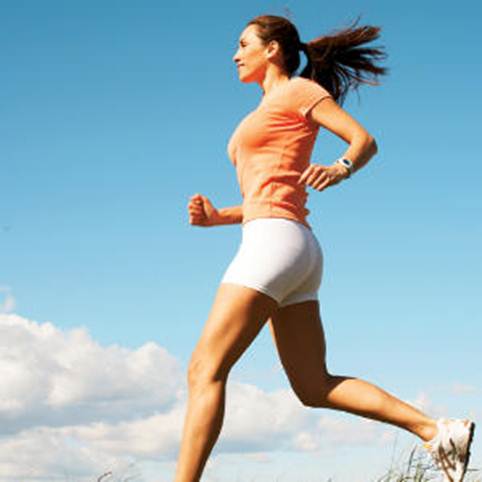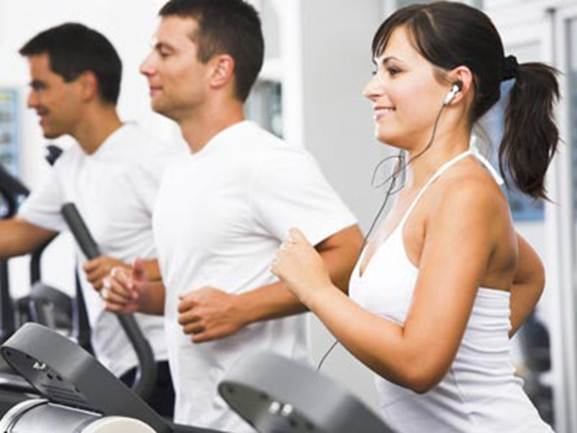The new exercise rules
Hands up anyone who can honestly say they
do 30 minutes or more of exercise five or six days a week? If the statistics
are right, that’s less than one on three of us. But there may be another way of
reaping the rewards of exercise without spending hours pounding the streets or
sweating it out in the gym. Unbelievable though it may sound, some experts
looking into the relationship between exercise and health are now arguing that
we may be able to achieve the key health benefits of exercise – in particular increased
insulin sensitivity to protect against diabetes and improved aerobic capacity –
just as effectively with as little as three minutes of flat-out high-intensity
training (HIT) each week.

“High-intensity
exercise breaks down the stored glucose in your muscles very rapidly, which
improves insulin sensitivity and, while walking or jogging only uses 20-30% of
your muscle cells, HIT activates more than 70%.”
The idea is based on the
principle of
interval training, explains Jamie Timmons, Professor of Systems Biology
at Loughborough University. This involves building short bursts of
high-intensity exercise
into your routine – so you might jog for 15 minutes and then run
flat-out for a
minute – and do it two or three times during your workout. “The
difference is
that interval training is still quiet time-consuming, while HIT is the
opposite. Yet it can deliver strong results – improved insulin
sensitivity,
aerobic fitness and muscle strength after just a few weeks,” explains
Professor
Timmons. “High-intensity exercise breaks down the stored glucose in your
muscles very rapidly, which improves insulin sensitivity and, while
walking or
jogging only uses 20-30% of your muscle cells, HIT activates more than
70%.”
When researchers in Canada compared two
groups – one doing 90-120 minutes of cycling six times over 14 days, the other
doing four to six 30-second bursts of flat-out cycling six times over the same
period (a total of 18 minutes compared to 12 hours) – they found the fitness
benefits were the same in each group. There are now almost a dozen studies
showing the same benefits.

“If
you have the time and want to do five hours of training a week, good on you..”
But if three minutes spread out over a week
sounds easy, be warned. It may be only seconds at a time, but you have to push
your body to its limits in those short bursts of activity to achieve results.
Still, Professor Timmons believes that with so many stating lack of time as
their reason to not exercise, the three-minute HIT regime might just inspire some
of them to get moving. “If you have the time and want to do five hours of
training a week, good on you – most people don’t. But no one can deny that they
have three minutes to exercise every week. If everyone took it up, we would
make a huge difference to public health over the next decade.”
And, he says, as long as you have the green
light from your doctor (or cardiologist, if you have a heart problem), you
don’t need to be super-fit to have a go. “We’ve done studies of patients with
obesity, diabetes and heart failure, so more or less everyone can do it. The
key point is that you have to achieve maximum effort, but only push yourself as
hard as you can within the constraints of your own fitness.”
Try it yourself
Practise this on an exercise bike, or adapt
it to an ordinary road bike, if you’re not used to exercise or have an existing
medical condition, always consult your doctor before attempting a new exercise
programme.

The
right diet and exercise… A winning combination!
- If you’re aged 18-50 and in good health,
warm up for two minutes with no resistance. Then cycle flat-out for 20
seconds with the resistance turned up high from the fifth second onwards –
it should be hard enough that you can manage 20 seconds and no more. Cycle
lightly for another two minutes or rest, then flat-out for another 20
seconds. Repeat one more time. Do this three times a week.
- If you’re over 50, warm up, then cycle
for 60 seconds at an intensity that sends your heart rate up and makes you
start to get out of breath. Rest for 60 seconds, then repeat. Try doing
this three time in the first week, building up to six to eight repetitions
by the fourth week.
- Keep your routine going, and attempt at
least two sessions per week. If you don’t have access to an exercise bike,
you can achieve the same effect by cycling uphill or using a cross-trainer
set at high resistance.
Keep moving and start losing
If all this still sounds like a step too
far, these is another way to burn extra calories and improve fitness – increase
your NEAT. This stands for Non-Exercise Activity Thermogenesis, which accounts
for much of our movement and the calories we expend during the day. Increasing
your NEAT simply means walking and moving more as you go about your daily life.
“It’s washing the car, walking to lunch, climbing stairs, folding laundry, even
tapping your feet. It’s not about going to the gym or taking an aerobics
class,” explains Professor James Levine in his book, Move A Little, Lose A Lot.
Professor Levine, an endocrinologist at the
Mayo Clinic in Rochester, USA, discovered the impact of NEAT when he tried to
work out why, when two groups of people eat the same number of calories, some
gain weight while others don’t. By overfeeding volunteers by 1,000 calories a
day and forbidding them any exercise, Levine found his answer. The difference
between the groups was simple – the non-gainers had a far higher NEAT.
Significantly, those who gained weight
spent, on average, two hours longer sitting each day than those who didn’t. As
Professor Levine points out, we are evolved to walk, yet many of us spend 80%
of the day sitting down. He estimates that by increasing our incidental
movement – largely by walking around more – we can increase our calorie burn by
500 calories or more a day.

A
long-term US study found women who spent six hours or more of leisure time
sitting had a 40% higher overall death rate than those who sat for three hours
or less.
When you sit, your muscle
activity drops
and your calories expended fall to around one a minute (a third of what
it
would be if you walked around). Research suggests spending too long
sitting –
and in some cases this seems to be regardless of whether you exercise or
not –
is unhealthy and could shave years off your life. A long-term US study
found women who spent six hours or more of leisure time sitting had a
40% higher overall
death rate than those who sat for three hours or less.
To
boost your own NEAT
·
Take phone calls standing up and, if possible,
pace around while you’re talking
·
At lunchtime spend 15 minutes eating and 30
minutes walking around.
·
Use the parking spot furthest from the shop or
office and take the stairs rather than the lift.
·
Instead of meeting friends for coffee, meet for
a walk and talk.
·
Put your wastepaper bin in the far corner of
your room or office so you have to walk to it.
·
Leave the remote next to the TV so you have to
get up to change channels.
·
Speak to colleagues in person rather than
emailing or phoning.
·
Whenever you can, stand rather than sit.